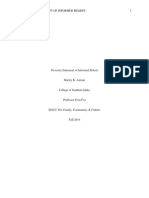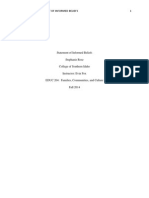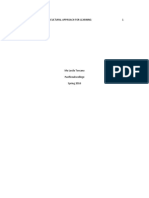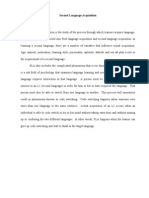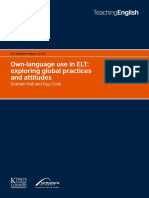Sib Paper-Final
Sib Paper-Final
Uploaded by
api-263907128Copyright:
Available Formats
Sib Paper-Final
Sib Paper-Final
Uploaded by
api-263907128Original Title
Copyright
Available Formats
Share this document
Did you find this document useful?
Is this content inappropriate?
Copyright:
Available Formats
Sib Paper-Final
Sib Paper-Final
Uploaded by
api-263907128Copyright:
Available Formats
Running head: STATEMENT OF INFORMED BELIEFS
Statement of Informed Beliefs
Jennifer Thompson
College Of Southern Idaho
Dr. Evin Fox
EDUC 204 Families, Communities and Cultures
Fall 2014
STATEMENT OF INFORMED BELIEFS
Diversity Statement of Informed Beliefs
Introduction
I believe all students can learn, specifically, all students have gifts and talents that will
help them learn. In studying Gardners theory of Multiple Intelligences those gifts and talents
will become apparent (Berns, 2011, p. 230). I believe we can all develop skills and talents even
in those areas for which we dont have a natural talent. Helping children learn how they learn
will give them a great foundation for growth. Children are not all the same and shouldn't be
taught as though they were. What students learn is directly related to how educators teach.
Students Ability to Learn
Believing all students can learn, I can use the uniquely accurate descriptions in Gardners
theory of the way people learn, with their inherent gifts and talents. These Multiple Intelligences
are verbal-linguistic, logical-mathematical, spatial-visual, bodily-kinesthetic, musical,
interpersonal, and intra-personal (Berns, 2011). With these they have a tendency to learn things
in different ways. As an educator I can apply Gardners Theory and help my students learn more
effectively. I can show them how to make the curriculum work for them. For example, if the
objective is to teach doubles addition facts, students can be taught using rhymes like 1+1=2
BOO 2+2=4 MORE 3+3=6 KICKS etc for verbal-linguistic learners.
Children do better with expectations and goals. Having exploration time is great,
however, children need objectives and ways to complete them. Children should be partners in
their learning. Discussing what will be taught each day will keep them in the loop and organized.
Study habits should be instilled early. Building on Gardners theory can help students with study
habits, and designing activities that will build on their natural talents (Berns, 2011). Additionally,
STATEMENT OF INFORMED BELIEFS
we are building on those they are less comfortable with. We must learn to do things that are not
in our comfort zone, making us stronger and well rounded.
Educators can be more effective applying Gardners theory while blending it with
Piagets theory of Cognitive Development (Berns, 2011). There will be age-appropriate
activities and expectations within their range of ability. These abilities can be built upon but
educators must be mindful of them and not have unreasonable expectations. Some students will
grasp language and reasoning while others may be better with spatial and abstract.
Temperament plays a part too. Children have varying ranges of characteristics that determine
how they respond to new experiences. Ultimately, it is up to educators to reach students, with
proper tools and foundation. Realistically, I know there are some who slip through the cracks or
have extreme issues. That doesnt exclude the idea of trying to reach them all. Teaching the
whole child is the point. How we teach is as important as what we teach. If the curriculum isnt
working, try something else. It may not mean the curriculum is wrong but that a different
approach is necessary.
Teaching the whole child includes providing a rich learning environment, ensuring that
there are elements that would appeal to any child. Teachers must understand that children need to
feel comfortable and encouraged to explore their classroom. The off-limit areas should be
skillfully camouflaged so the room is inviting and children can reach and investigate with few
restrictions. Color should be present in a functional aesthetic way. Developmentally
appropriate centers should provide a variety of learning experiences. Centers should be fluid
and adaptable for childrens changing interests or current concepts being introduced and studied.
STATEMENT OF INFORMED BELIEFS
Activities should provide students hands-on personal experiences. Seat work has its place but,
not as a standard for the whole day.
Students Social Ecology Theory
Before entering school, children experience socialization in their home environment or
ecosystem. As educators we must have an understanding of the Social Ecology of our students.
It has a direct influence on how students assimilate their school experience. Each family has its
own social system called a microsystem. This is where children learn what is acceptable and
unacceptable. Many valuable skills for adaptation will be fostered by parents and family. Those
rules may or may not coincide with rules they will encounter at school. There may be a longer
adjustment period for some, due to their familys unique system.
We need to understand what is considered commonplace in their homes. Links between
these two microsystems are referred to as a Mesosystem. Socially acceptable behavior has to be
introduced and reenforced while not denigrating their home life. Understanding possible family
systems our students may have, we can better aid in their transition. The demographics or the
statistical characteristics of the school district will impact the behaviors and skills with which
children enter school. Demographics are part of the larger influence of Macrosystems. These
systems can include large religious groups, ethnicity of the residents and socioeconomic status
of families in the area.
Children are socialized by the community they grow up in. Whether thats rural, urban or
somewhere in-between, there is an effect. Children see the effects of the parents job on their
family system. Daily routines are affected by the community. A child growing up in a big city or
a child living in a farming community may wonder where they fit in. They learn this through
STATEMENT OF INFORMED BELIEFS
parent interactions and at school. They should be given the opportunity to learn about the world,
not just their own community. Exposing children to diverse cultures, may offer a new point of
view that encourages exploration.
A childs culture is a significant factor in socialization. Family cultures can be very
inclusive parts of a childs life, affecting each aspect of their life. Therefore, that culture needs to
be respected. These may be ethnic, religious or occupational. Ethnic backgrounds will have
traditions and expectations that other children may not have, such as language and annual
customs. The beliefs and practices of the familys religion affect children at school. These are
often as beloved as ethnic traditions and practices. Occupational refers to a parents job/career.
Careers like farming have a unique family culture that is an intricate part of that job.
Cultural Diversity Instruction
We must find a way to welcome diverse cultures. Inviting family members to share their
experiences and knowledge brings a spice to the classroom. Our students may not have any
experience with other cultures. Celebrating the differences, and acknowledging any similarities
will aid in understanding those cultures. Providing a solid foundation for tolerance as they
progress through school, educators should be willing to include diverse cultures into class and
spotlight them. There are traditions and practices that may, from the outside, seem odd or even
wrong. Openly and calmly discussing them will smooth the way toward tolerance and respect for
cultures that are not our own.
Cultural Pluralism is a concept that involves a smaller groups culture that is accepted
by the greater group culture. This is like the large Hispanic culture here in the Magic Valley.
This culture holds tight to its traditions and language and is accepted. Despite the language
STATEMENT OF INFORMED BELIEFS
barrier these children and families are able to progress and thrive with aid and acceptance from
the community. This culture remains intact and accepted by others within the whole community.
Cultural Assimilation is when a culture is lost and the group completely joins the
communitys established culture. This has happened to many Native American Tribes. We still
have the reservations for some of them but much of their culture and many members have
assimilated completely to modern culture.
When a culture remains intact and functioning, the members of that culture retain their
unique traditions and practices. Many cultures are beautiful, with valuable traditions that should
be valued. When a culture is completely assimilated the traditions are lost and those members
lose that connection to their ancestors. Though, they may gain an easier transition, as this may
alleviate any persecution or feelings of not belonging.
Curriculum for All Learners
Curriculum must be flexible, adaptable and diverse. No matter what curriculum is
enforced in a district, there are ways to make it work. Pulling out ones own knowledge, using
tools and resources to ones advantage, will give students a better opportunity to learn. Flexible
lessons that involve the whole class, are much more valuable, than cookie cutter curriculum
that will not reach all students. As Gardners theory shows, there are several different kinds of
learners (Berns, 2011). Some will need the hands-on, visuals, music etc, to capture their attention
and allow for exploration. All children need to adapt to other kinds of teaching styles, building
on the areas they are not naturally inclined toward. This is where diverse lesson plans will benefit
the entire class, providing each type of learner with opportunities to excel.
STATEMENT OF INFORMED BELIEFS
We need to be ready for unplanned teachable moments. When opportunities arise the
educator must have the willingness to act. Children are not little robots. Ideas and questions often
occur to them at inopportune times. As teachers we can offer them an opportunity to expand their
knowledge even if it isnt on the schedule.
Children are unpredictable and may not assimilate the lesson. Teachers need to have a
back-up plan for expanding on, breaking down the subject or for building on it. If the students
are not getting it, come at the problem from another angle. There are many ways to teach
concepts and appealing to a diverse group of children will require versatility from the teacher. If
the students are not learning, the teacher is responsible for getting through to them. There are
difficult students, but with determination and a positive attitude most can be reached. Be open to
new techniques that may be out of your comfort zone. Careful observation and clear notes will
aid in evaluations of the learning process happening in class. Observations will help you with the
direction that any change needs to take.
Frequent informal assessments are a valuable tool. We must be checking for
comprehension to know what has been assimilated. Re-teaching may be necessary for students to
learn the concept. Formal assessments are an important element of student progression but
teachers can put their students at ease with a short pre-test chat. Inform them of what is going to
happen and the expectations. Remember, that too much testing may cause undue pressure on
your students. Assessments should be diverse providing the students the opportunity to become
familiar with many types.
A key element of the teaching experience is knowing why one is teaching. Is it because of
summers and holidays off or for the of love children and a desire to touch lives. I greatly enjoy
STATEMENT OF INFORMED BELIEFS
working with children and want to see them succeed. That is why I want to teach. Teachers are
there to guide, encourage and open up the world of possibilities to children.
As educators, we should be able to see the possibilities, and what can be shared with
students. Teachers can talk about the 5 senses and show a picture, but providing a hands-on
experience is far better. One can tell and show children the alphabet or teachers can sing songs
and do fun art projects that will make the letters more real to them. Teachers can read to students
or have them read to themselves (depending on age) or you can do silly voices, ask questions that
get them involved and thinking about the story and use technology to enhance the experience.
These are a few of the possibilities. Thinking outside the box is key.
Conclusion
Educators that are able to be flexible, adaptable and open to diversity are a valuable asset.
They are ready for teachable moments, can see the possibilities, and know why they are teaching.
Those teachers will touch lives providing students with the tools and knowledge to succeed in
their endeavors. The students may not always succeed, but they will not be afraid to try. They
will have had valuable experiences and have been loved and encouraged by someone who
believed they were worthwhile. Children will be in the best possible condition to move forward
with the this kind of teaching.
STATEMENT OF INFORMED BELIEFS
8
Reference
Berns, R. M. (2011). Child, Family, School, Community: Socialization and Support. United
States. Wadsworth Cengage Learning.
You might also like
- Professional Philosophy StatementDocument1 pageProfessional Philosophy Statementapi-550367581100% (2)
- Chapter 2 Bridging The GapDocument7 pagesChapter 2 Bridging The GapYến HảiNo ratings yet
- On Social ProcessDocument31 pagesOn Social ProcessAmlan jyoti thanapati0% (1)
- Dsib Rough DraftDocument8 pagesDsib Rough Draftapi-235713087No ratings yet
- Final Statement of Informed BeliefsDocument9 pagesFinal Statement of Informed Beliefsapi-679365507No ratings yet
- Running Head: Statement of Informed Beliefs 1Document9 pagesRunning Head: Statement of Informed Beliefs 1api-254153086No ratings yet
- Diversity Statement of Informed BeliefsDocument10 pagesDiversity Statement of Informed Beliefsapi-242587194No ratings yet
- Sib 5 FidanzaDocument10 pagesSib 5 Fidanzaapi-383622059No ratings yet
- Statement of Informed Beliefs 1Document9 pagesStatement of Informed Beliefs 1api-404799970No ratings yet
- Sib FinalDocument8 pagesSib Finalapi-300698140No ratings yet
- Statement of Informed Beliefs Essay Sarah Wagner Prof. Carol Billing EDUC 204 Families, Communities, & CultureDocument8 pagesStatement of Informed Beliefs Essay Sarah Wagner Prof. Carol Billing EDUC 204 Families, Communities, & Cultureapi-355514594No ratings yet
- Finaldraft2 1Document7 pagesFinaldraft2 1api-354956404No ratings yet
- Module - 3 SOCIAL STUDIESDocument5 pagesModule - 3 SOCIAL STUDIESGervin Capablanca100% (1)
- Running Head: Statement of Informed Beliefs 1Document9 pagesRunning Head: Statement of Informed Beliefs 1api-273543006No ratings yet
- Final Sib Paper 204Document8 pagesFinal Sib Paper 204api-303046151No ratings yet
- Every Child Deserves A ChampionDocument8 pagesEvery Child Deserves A Championapi-273681008No ratings yet
- Sib FinalDocument7 pagesSib Finalapi-404803522No ratings yet
- Dawn Beaver DsibDocument7 pagesDawn Beaver Dsibapi-374669914No ratings yet
- Running Head: Multiculturalism 1Document9 pagesRunning Head: Multiculturalism 1api-276414713No ratings yet
- Cultural Proficiency ResourcesDocument5 pagesCultural Proficiency Resourcesapi-240756804No ratings yet
- Educ 204 SibDocument9 pagesEduc 204 Sibapi-242679834No ratings yet
- Bachelor of Technical Vocational Teaching Education 1 1Document8 pagesBachelor of Technical Vocational Teaching Education 1 1Joan Dela Cruz IsipNo ratings yet
- Aspire To Inspire As A TeacherDocument8 pagesAspire To Inspire As A Teacherapi-314975923No ratings yet
- Ped 102 g2 Final Write UpsDocument28 pagesPed 102 g2 Final Write UpsJeanraiza CorpuzNo ratings yet
- Statement of Informed BeliefsDocument6 pagesStatement of Informed Beliefsapi-341995386No ratings yet
- Addressing Literacy Needs in Culturally and LinguisticallyDocument28 pagesAddressing Literacy Needs in Culturally and LinguisticallyPerry Arcilla SerapioNo ratings yet
- Ed213 Foundations of Ed. Module 1. EsparagozaDocument42 pagesEd213 Foundations of Ed. Module 1. EsparagozaCL ARMADANo ratings yet
- Profed9 EssayDocument6 pagesProfed9 Essayalmaalana.detablanNo ratings yet
- Why Focus On Cultural Competence and Culturally Relevant Pedagogy?Document4 pagesWhy Focus On Cultural Competence and Culturally Relevant Pedagogy?yankumi07No ratings yet
- The Key Factors That Can Affect The Way Pupils Learn Including Age, Gender, and Physical, Intellectual, Linguistic, Social, Cultural and Emotional DevelopmentDocument2 pagesThe Key Factors That Can Affect The Way Pupils Learn Including Age, Gender, and Physical, Intellectual, Linguistic, Social, Cultural and Emotional DevelopmentDoodah2100% (1)
- Educ 7 - Portfolio - Joycelen Mae SantaDocument8 pagesEduc 7 - Portfolio - Joycelen Mae SantaJoycelen Mae Tejero SantaNo ratings yet
- Creating A Multicultural Classroom EnvironmentDocument3 pagesCreating A Multicultural Classroom EnvironmentAzreyzan BahamanNo ratings yet
- Mcconnell Final SibDocument7 pagesMcconnell Final Sibapi-437149548No ratings yet
- Running Head: Statement of Informed Beliefs 1Document10 pagesRunning Head: Statement of Informed Beliefs 1api-256252785No ratings yet
- Dsib FinalDocument5 pagesDsib Finalapi-296336913No ratings yet
- Diversity of Informed Beliefs 2nd Final EssayDocument7 pagesDiversity of Informed Beliefs 2nd Final Essayapi-385282003No ratings yet
- Gennasib1 - 5 Educ204Document9 pagesGennasib1 - 5 Educ204api-356514016No ratings yet
- Statement of Informed Beliefs DraftDocument6 pagesStatement of Informed Beliefs Draftapi-318046870No ratings yet
- Running Head: Statement of Informed Beliefs 1Document8 pagesRunning Head: Statement of Informed Beliefs 1api-302824987No ratings yet
- Dsib FinalDocument7 pagesDsib Finalapi-341395926No ratings yet
- Edfd 227 Question 4 s00142914Document8 pagesEdfd 227 Question 4 s00142914api-254146673No ratings yet
- Teaching Diverse Students in Diverse Environment: Lornilrn Manugot Leah ArtajoDocument16 pagesTeaching Diverse Students in Diverse Environment: Lornilrn Manugot Leah ArtajoDianne DiamNo ratings yet
- Assignment 2 Edu 300005 2Document11 pagesAssignment 2 Edu 300005 2smvvpadmaNo ratings yet
- Making A Case For A Multicultural Approach For Learning 412 1Document8 pagesMaking A Case For A Multicultural Approach For Learning 412 1api-384483769No ratings yet
- Prof Ed 4 - Activity 1Document2 pagesProf Ed 4 - Activity 1Sarah Luz PelayoNo ratings yet
- Presentation 1Document12 pagesPresentation 1api-351330683No ratings yet
- A Ed 204 FinalDocument6 pagesA Ed 204 FinalchriskghtNo ratings yet
- Dsib 204Document9 pagesDsib 204api-263184109No ratings yet
- Philosophy2 0Document3 pagesPhilosophy2 0api-311209583No ratings yet
- Learning Diversity 103 REPORTDocument2 pagesLearning Diversity 103 REPORTDebex IbsotNo ratings yet
- Sib AssignmentDocument7 pagesSib Assignmentapi-415905015No ratings yet
- D Blanco hd412 Multiculturalcurriculum 110815Document7 pagesD Blanco hd412 Multiculturalcurriculum 110815api-282907054No ratings yet
- Actual TRF 2023 IvanDocument15 pagesActual TRF 2023 IvanYoliveBahi-anBalbuenaNo ratings yet
- Week 1 - PA Submission Edu 5711Document8 pagesWeek 1 - PA Submission Edu 5711annyjamesjonahNo ratings yet
- Powerpoints-Week 1 Lecture 4Document14 pagesPowerpoints-Week 1 Lecture 4humantechhkNo ratings yet
- Concept and Meaning of Diverse NeedsDocument8 pagesConcept and Meaning of Diverse NeedsAravind RayapudiNo ratings yet
- Statement of Informed BeliefsDocument9 pagesStatement of Informed Beliefsapi-243379140No ratings yet
- Artifact 412Document9 pagesArtifact 412api-418118361No ratings yet
- Cultural Diversity Research Project and ReflectionDocument7 pagesCultural Diversity Research Project and Reflectionapi-340127786No ratings yet
- Socio-Cultural Factors in Multigrade TeachingDocument26 pagesSocio-Cultural Factors in Multigrade TeachingGlesie Gabales100% (1)
- Module 4 Activity - TanudraDocument3 pagesModule 4 Activity - TanudraJanber Engell Gabriel TanudraNo ratings yet
- Unlocking the Brilliance Within: A Guide for Parents and Teachers of Special Needs ChildrenFrom EverandUnlocking the Brilliance Within: A Guide for Parents and Teachers of Special Needs ChildrenNo ratings yet
- Socio Lesson 2 PDFDocument53 pagesSocio Lesson 2 PDFKhoa DoNo ratings yet
- Program Studi Pendidikan Bahasa InggrisDocument2 pagesProgram Studi Pendidikan Bahasa InggrisDevi Rafealia WijayantiNo ratings yet
- Adams - Radical Integration PDFDocument53 pagesAdams - Radical Integration PDFtisafk100% (1)
- RPS Academic VocabullaryDocument5 pagesRPS Academic Vocabullaryamy krisdiana fkipNo ratings yet
- 5 Esl Report Card CommentsDocument3 pages5 Esl Report Card Commentserliatj100% (1)
- Module 5-Diversity and PluralismDocument31 pagesModule 5-Diversity and Pluralismjaitik nagpalNo ratings yet
- What Is InterlanguageDocument17 pagesWhat Is Interlanguagejaja salesNo ratings yet
- Learners Individual Progress Report in ReadingDocument4 pagesLearners Individual Progress Report in ReadingCharmaine GalleneroNo ratings yet
- Baja - RM - EL 103 - SMA1Document4 pagesBaja - RM - EL 103 - SMA1Ro MelNo ratings yet
- (Fossilization in Adult Second Language Acquisition) FrontmatterDocument4 pages(Fossilization in Adult Second Language Acquisition) Frontmatterdavid taborda betancurNo ratings yet
- A Global LanguageDocument28 pagesA Global LanguageInsaf AliNo ratings yet
- A Guide To Level 1 (Northern) : Gwers 1Document12 pagesA Guide To Level 1 (Northern) : Gwers 1mtemei4414No ratings yet
- ACTIVITY-Exploring Interlanguage Theory Through Error Analysis and CorrectionDocument2 pagesACTIVITY-Exploring Interlanguage Theory Through Error Analysis and CorrectionELDA P. SAYA-ANGNo ratings yet
- Caribbean Studies Module 1 NotesDocument6 pagesCaribbean Studies Module 1 NotesLiba calmaNo ratings yet
- Second Language AcquisitionDocument2 pagesSecond Language AcquisitionhudaNo ratings yet
- Here Lies LaloThe Collected Works of Abelardo DelgadoDocument225 pagesHere Lies LaloThe Collected Works of Abelardo DelgadoArte Público PressNo ratings yet
- SUNUM DilbilimiDocument2 pagesSUNUM DilbilimidoğaNo ratings yet
- Own-Language Use in ELT - Exploring Global Practices and Attitudes Graham Hall and Guy CookDocument7 pagesOwn-Language Use in ELT - Exploring Global Practices and Attitudes Graham Hall and Guy CookJuan Ignacio PalacioNo ratings yet
- Two Thousand Million?Document4 pagesTwo Thousand Million?gkbea3103100% (4)
- Sociolinguistics Lesson 3 Lecture SlidesDocument31 pagesSociolinguistics Lesson 3 Lecture SlidesPearl Trần100% (1)
- English File: Answer SheetDocument1 pageEnglish File: Answer SheetRomanNo ratings yet
- CPMT Act 1Document1 pageCPMT Act 1Justeen BalcortaNo ratings yet
- Kabanata 5 Thesis Sample TagalogDocument6 pagesKabanata 5 Thesis Sample Tagalogafknwride100% (2)
- From Monolingual To Multilingual - Language Programs and Policies Across ASEAN Countries Written Report (Highlighted)Document4 pagesFrom Monolingual To Multilingual - Language Programs and Policies Across ASEAN Countries Written Report (Highlighted)Mari Felizardo75% (4)
- Answer A Sports QuestionDocument13 pagesAnswer A Sports QuestionOlga ZybtsevaNo ratings yet
- Visual Aids Make A Big Impact On ESL Students - A Guidebook For ESDocument119 pagesVisual Aids Make A Big Impact On ESL Students - A Guidebook For ESDeko KenNo ratings yet
- Paper Group 5 - Error Analysis - Sources of Error - RevisionDocument14 pagesPaper Group 5 - Error Analysis - Sources of Error - RevisionMyfashionstoreNo ratings yet
- Sf1 - 2022 - Grade 7 (Year I) - HonestyDocument8 pagesSf1 - 2022 - Grade 7 (Year I) - HonestyLiza MalaluanNo ratings yet













